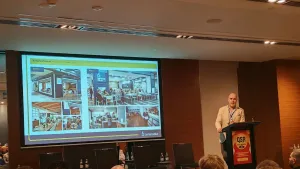
From tech to table: The role of tech in today's QSR industry
As technology takes over businesses across industries, the words ‘digitalisation,’ ‘technological innovation,’ ‘digital competence,’ ‘disruptive technology,’ and many others often come up in business discussions.
Whilst industries such as media, finance, and professional services have fully embraced innovation and now have highly advanced digital capabilities, some businesses, including QSRs seem to be falling behind.
A 451 Research study commissioned by Adyen in 2019 reveals that only 25% of QSRs have a formal digital strategy, compared to 51% of grocery chains and 51% of luxury retail stores. This is worrisome because as customers increasingly become tech-savvy, they expect to get products and services whenever, wherever, and however they want them, with just one tap on their gadgets.
In the QSR industry, diners demand better apps and improved checkout experiences. In fact, according to the same study, more than 60% of customers said the ability to pay for products or services through a messaging app would increase their likelihood to make purchases. Hence, QSRs need to up their game in digital technologies, especially in checkout and payment processes, if they want to capture this lucrative opportunity.
It is imperative for QSRs to have the technological capabilities that allow customers to order and pay using the platform of their preference. Michel van Aalten, Country Manager for Australia and New Zealand at Adyen, says “customers now have more control than ever, and if they are unable to engage with a brand or make a purchase on the channel that they use, brands miss an opportunity for a sale.”
According to a study by Forrester commissioned by Adyen, businesses using a single, unified payments platform enjoy operational efficiencies, consolidated compliance and regulatory fees, and fewer processing fees and chargebacks. With a unified payments platform, QSRs can take advantage of these efficiencies and cost-savings, not to mention the countless benefits of having a single source of customer data available at their fingertips.
Forrester estimates that an organisation with approximately $2 billion in revenue that uses one platform saves a total of $5.8 million over a three-year period. QSRs need to make the most of the fact that customers are constantly in front of their screens and think of ways to best serve them through whichever channel they use. 451 Research notes that these wired consumers want three major things: convenience, context, and control.
A unified payments platform, according to van Aalten, helps QSRs deliver these three C’s by providing a single view of the customer across all channels.
“A good payments platform enables convenience in that it allows QSRs to offer fast, easy, and frictionless dining experiences across a broad range of channels, including in-store counter, kiosks, app and web. It also addresses customers’ demand for context by providing personalised offers based on purchasing behaviour across all channels, and giving customers control over how to order and which payment methods they would like to use,” says van Aalten.
Global QSR giants such as Subway and McDonald’s attest to the many benefits of how a good unified payments platform helps improve customer engagement, and consequently increase revenues. Chief Information Officer of Subway Mike Macrie says, “As we continue our digital push to offer our guests greater convenience and more options, Adyen’s payment platform will further allow Subway to bring the latest digital payment technologies to market, whilst removing operational complexities for our Franchise Owners.”
Similarly, McDonald’s rolled out Adyen’s platform in several markets internationally. Leandro Balbinot, SVP of Global Technology and Digital at McDonald’s, says, “With Adyen’s scalable platform, McDonald’s will be able to continue to provide customers a seamless experience through a variety of payment methods that align with the unique needs of our markets.”
To read Adyen’s full report on how technology is changing the QSR industry, click here.



























